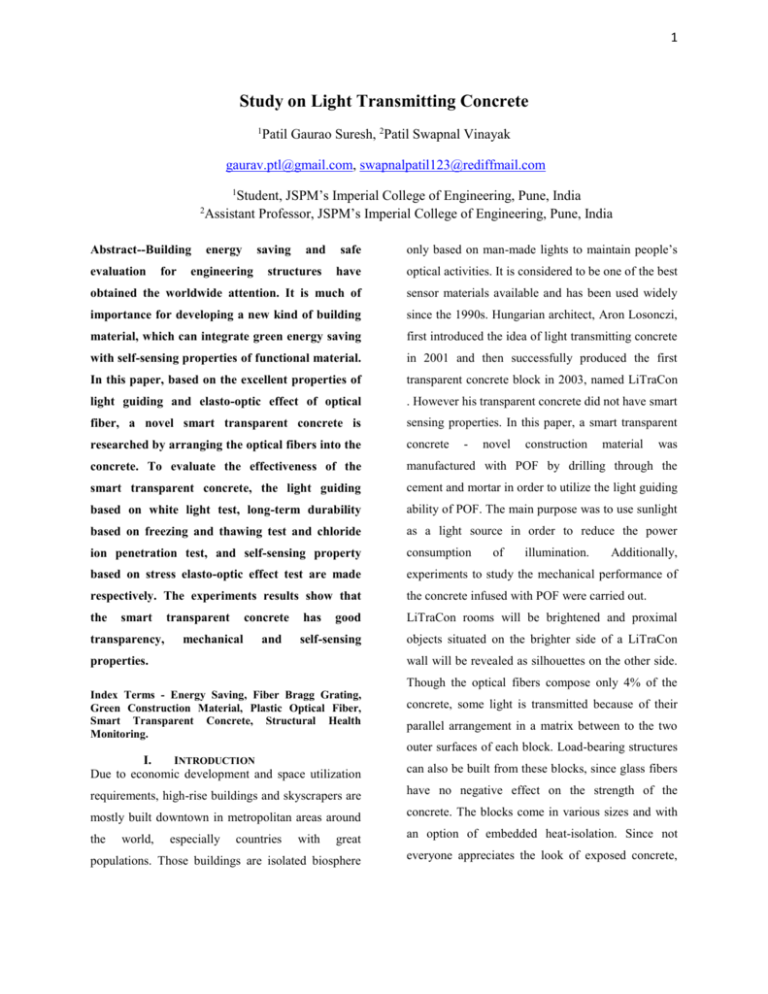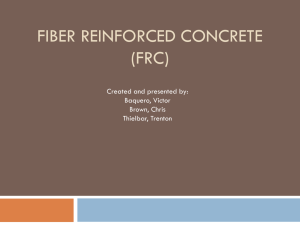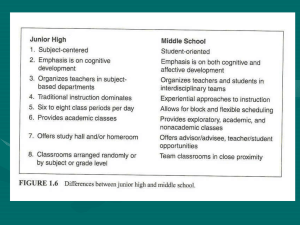Study on Light Transmitting Concrete
advertisement

1 Study on Light Transmitting Concrete 1 Patil Gaurao Suresh, 2Patil Swapnal Vinayak gaurav.ptl@gmail.com, swapnalpatil123@rediffmail.com Student, JSPM’s Imperial College of Engineering, Pune, India Assistant Professor, JSPM’s Imperial College of Engineering, Pune, India 1 2 safe only based on man-made lights to maintain people’s have optical activities. It is considered to be one of the best obtained the worldwide attention. It is much of sensor materials available and has been used widely importance for developing a new kind of building since the 1990s. Hungarian architect, Aron Losonczi, material, which can integrate green energy saving first introduced the idea of light transmitting concrete with self-sensing properties of functional material. in 2001 and then successfully produced the first In this paper, based on the excellent properties of transparent concrete block in 2003, named LiTraCon light guiding and elasto-optic effect of optical . However his transparent concrete did not have smart fiber, a novel smart transparent concrete is sensing properties. In this paper, a smart transparent researched by arranging the optical fibers into the concrete concrete. To evaluate the effectiveness of the manufactured with POF by drilling through the smart transparent concrete, the light guiding cement and mortar in order to utilize the light guiding based on white light test, long-term durability ability of POF. The main purpose was to use sunlight based on freezing and thawing test and chloride as a light source in order to reduce the power ion penetration test, and self-sensing property consumption based on stress elasto-optic effect test are made experiments to study the mechanical performance of respectively. The experiments results show that the concrete infused with POF were carried out. the good LiTraCon rooms will be brightened and proximal self-sensing objects situated on the brighter side of a LiTraCon Abstract--Building evaluation for smart transparency, energy saving engineering transparent structures concrete mechanical and and has - novel of construction illumination. material was Additionally, wall will be revealed as silhouettes on the other side. properties. Though the optical fibers compose only 4% of the Index Terms - Energy Saving, Fiber Bragg Grating, Green Construction Material, Plastic Optical Fiber, Smart Transparent Concrete, Structural Health Monitoring. concrete, some light is transmitted because of their parallel arrangement in a matrix between to the two outer surfaces of each block. Load-bearing structures I. INTRODUCTION Due to economic development and space utilization can also be built from these blocks, since glass fibers requirements, high-rise buildings and skyscrapers are have no negative effect on the strength of the mostly built downtown in metropolitan areas around concrete. The blocks come in various sizes and with the great an option of embedded heat-isolation. Since not populations. Those buildings are isolated biosphere everyone appreciates the look of exposed concrete, world, especially countries with 2 LitraCon is creating light-transmitting building become a structural component as a kind of modest blocks in other textures and colors as well. With over aggregate. So, the surface of can be built with these seven billion cubic meters produced each year, blocks and the blocks can be produced in various concrete is one of the world’s most ubiquitous sizes and with embedded heat-isolation. building materials. Concrete use has stood the test of Litracon is a combination of optical Fiber s and fine time and is a multibillion dollar industry that concrete. It can be produced as prefabricated building provides millions of jobs throughout the world. blocks and panels. Due to the small size of the Fiber Despite its versatility and popularity, the aesthetic s, they blend into concrete becoming a component of reputation of concrete leaves must to be desired. the material like small pieces of aggregate. In this Common descriptive phrases such as “CONCRETE manner, the result is not only two materials - glass in JUNGLE” do little to increase the desirability of concrete - mixed, but a third, new material, which is concretes aesthetic attributes. homogeneous in its inner structure and on its main This concept of LiTraCon was invented by Mr. Aron surfaces Losonczi. He was a Hungarian Architect. He saw the The glass Fiber s leads light by points between the piece of artwork that was made up of large glass two sides of the blocks. Because of their parallel pieces and ordinary concrete which gives the artwork position, the light-information on the brighter side of translation properties. Seeing this, he got an idea of such a wall appears unchanged on the darker side. combining two materials to create transmitting The most interesting form of this phenomenon is concrete. Instead of using large glass pieces, he uses probably the sharp display of shadows on the thousands of glass fibers mixed with fine concrete. opposing side of the wall. Moreover, the color of the The fibers form a matrix and run parallel to each light also remains the same. as other between the two surfaces of each block. The mixture can achieve translucent effect with only 4% of its volume consisting glass fibers. Because of small size of glass fibers, they blend into the concrete and become a part of its structural integrity and are not visible on the surface. The resulting product looks and behaves like pure concrete but shadows and objects show through similar that of Japanese sliding screens made of rice paper. II. PRINCIPLE Thousands of optical glass fibers form a matrix and run parallel to each other between the two main surfaces of each block. The fibers mingle in the concrete because of their insignificant size and they Figure.1 Transparent wall well. 3 This new product, then, is a combination of optical light guiding and sensing advantages, such as anti- fibers and fine concrete and can be produced as electromagnetic building blocks or panels. The fibers blend into the dimensions, distributed measurement and anti- concrete and become part of the material like small corrosion characteristics, optical Fiber s have been pieces of aggregate. You not only get two materials, widely adopted in the communication and sensing glass in concrete, but a third new material, which is fields. It is considered to be one of the best sensor homogeneous in its inner structure and on its main materials available and has been used widely since surfaces, too. the 1990s. Hungarian architect, Aron Losonczi, first interference capability, small introduced the idea of light transmitting concrete in III. LITERATURE REVIEW 2001 and then successfully produced the first Research and Development of Plastic Optical Fiber transparent concrete block in 2003, named LiTraCon. Based Smart Transparent Concrete Zhi Zhou1,2, GeOu, Ying Hang, Genda Chen, Jinping Ou, School of Civil Engineering, Harbin Institute of Technology, Harbin 150090, P.R. China Center for Infrastructure Engineering IV. MATERIALS A. Optical Fibers Studies, Missouri Univ. of Science and Tech., Rolla, MO 65401-0710, USA School of Civil and Hydraulic Engineering, Dalian University of Technology, Dalian, 116024, P.R. China Structural Health Monitoring (SHM), it is a promising technology for field applications in civil infrastructure. Due to economic development and space utilization requirements, high rise buildings and skyscrapers are mostly built downtown in metropolitan areas around the world, especially those countries with great populations. Those buildings are Figure 2. Total Internal Reflection isolated biosphere only based on man-made lights to maintain people’s optical activities. For example, When light traveling in an optically dense medium China consumes 25% of global architectural energy hits a boundary at a steep angle (larger than the and 13% of that energy is used to power lighting. At critical angle for the boundary), the light is present, green structures focus greatly on saving completely reflected. This is called total internal energy with indoor thermal systems. However, in the reflection. This effect is used in optical fibers to area of illumination fields, there is very little research confine light in the core. Light travels through the offering relevant solutions. Research on the intrinsic fiber core, bouncing back and forth off the boundary characteristics of the optical identity in construction between the core and cladding. Because the light materials is still at its infancy. Due to its outstanding must strike the boundary with an angle greater than 4 the critical angle, only light that enters the fiber this acceptance cone is a function of the refractive within a certain range of angles can travel down the index difference between the fiber's core and fiber without leaking out. This range of angles is cladding. called the acceptance cone of the fiber. The size of B. Translucent Stone A minimum amount of fine arising from binders and sand must be achieved to avoid segregation. Another deficiency in aggregate is poor gradation. The use of filters is suggested as means of overcoming this problem. At present, a trial and approach is used to fix the type and amount filter. Alternative, particle packing model should be used to reduce the number of experimental trials. The overall idea is to overcome local deficiencies in aggregate shape and to arrive at required packing characteristic irrespective of aggregate. In the view of an increase awareness of Figure 3. Translucent Stone the same, use of manufactured sand and other alternative fine aggregate has become essential. In This naturally occurring stone is highly scissile, so fact, river sand is simply not available in future years. this material can be worked into thinnest layers. V. These layers are so thin that when backlit, the light can pass through the stone and thereby generates CHARACTERISTICS Permits the passage of light through the set impressive visual effects. The always unique mineral concrete, permitting colors, shapes and structure, the different colors and different light outlines to be seen through it transmissions generates an always unique materiality, which will convince in various applications, like in interior design, in exhibition design as well as in varies from 150 MPa up to 250 MPa furniture and display design. C. Cement Having a resistance to compression that Having maximum water absorption of 0.35%. Having a maximum oxygen index of 25%. Having a thermal conductivity of 0.21 W/m Selection of the type of cement will depend on °C. overall requirement for the concrete such as strength Having an elastic limit greater than 60 MPa. and durability. Having a Young's Modulus from 2750 MPa to 3450 MPa D. Fine Aggregate All normal concreting sands are suitable for litracon. Both crushed and rounded sand can be used. From its characteristics and composition, can be a conductor of electricity, dispensing with interior. 5 optical structural and under conditions of service characteristics, can be used for purposes that equal to and even different from those of a are both architectural and aesthetic, and also traditional concrete. From VI. its mechanical and APPLICATIONS A. Illuminate Your Walls Galaxy Translucent Concrete can be used as building material for interior and exterior walls. If sunshine illuminates the wall structure then eastern or western placement is recommended; the rays of the rising or setting sun will hit the optical glass fibers in a lower angle and the intensity of the light will be bigger. Besides the traditional applications of a wall, the light transmitting concrete can also be used as wall covering illuminated from the back. Figure 5. Creative Column C. Translucent Concrete Stairs With Impact Lighting Inc’s Linear LED fixtures our Galaxy Translucent Concrete product can be used in horizontal and vertical applications such as feature stairs, walls, flooring, tables and counter tops. Figure 4. Wall Illuminated By Litracon B. Creative with Design The building units are versatile and can be used in many areas of design. You can also create a logo with colorful figures, inscriptions and pictures A. Figure 6. Translucent Concrete Stairs 6 VII. Mixing the cement with water according to the proportions can be used as aggregates, for example, gravels, MANUFACTURING PROCESS sands, etc. formulation of this concrete is diglycidyl ether of Mixing the polymer matrices with the respective bisphenol A (DGEBA) which is dehydrated in catalyst or hardener; and vacuo at 80° C. for 8 hours prior to use. The Mixing the previous two mixtures with the other epoxide equivalent of the resin was determined by components in the proportions described. Formulation for obtaining a translucent concrete mixture, comprising a mixture of epoxy and potentiometric methods. triamine(DETA) and Portland cement. sieves prior to use. produced, starting from a monomer which, thanks mixture according to claim 1, wherein the content to the fact that it has two aryl groups at its ends and of the components is: epoxy matrix from 0% to these in turn contain carbon-carbon double bonds, 90%, and the polycarbonate matrix from 0% to can be polymerized by a vinyl polymerization by 60%, fiberglass from 0% to 10%, colloidal silica sol means of free radicals. In this way, all the chains from 0.5% to 5%, silica from 0.5% to 10%, will join up one with another in order to form a diethylene triamine (DETA) from 10% to 50%; from 0% to 15%. cross-linked material. wetting of lengths greater than 0.02 mm, with the was of the binder type, in order to give it the function of improving the resistance of the concrete necessary rigidity, and it can be any polymeric preferably being used, one an epoxy and the other a polycarbonate, each accompanied by its respective catalyst, so that, when reacted chemically, the concrete is formed on setting. The formulation also uses Portland type cement, preferably white, for the formulation of the inventive concrete. The aggregates used in the manufacture and formulation were fiberglass, silica, colloidal silica sol and optical fibers. Optionally, rocky elements Glass fibers were used without any kind of wetting, Mat. of cut thread, ground fibers deprived of The matrix used in the formulation of this concrete matrix or binder, with two polymeric matrices A polycarbonate was chosen totally different from the polycarbonate of bisphenol A, which is Formulation for obtaining a translucent concrete optical fibers from 0% to 3% and Portland cement The setting agent used is diethylene triamine (DETA), which has to be dehydrated on molecular polycarbonate matrices, plus fiberglass, optical fibers, colloidal silica sol, silica and diethylene The epoxy matrix or binder used for the to compression, bending, tension and torsion. The optical fibers used in the formulation of this concrete are basically fine glass or plastic threads that guide the light. The communication system arises from the union between the light sources that are sufficiently pure for not being altered. The types of fibers used are monomode and virgin fibers, in other words, those in the pure state and without any coatings, the aim of which is so that the light can pass through the concrete and can in turn be used as electrical conductors. 7 VIII. CONCLUSION A smart transparent concrete is aesthetically pleasing. POFbased transparent concrete could be regarded as an art which [5]K.S.C. Kuang, M. Maalej, S.T. Quek. Hybrid optical fiber sensor system based on fiber Bragg gratings and plastic optical fibers for health monitoring of engineering structures. could be used in museums and specific exhibitions rather Proc. of SPIE, 6174(61742P) :1-12, 2006. than just a construction material. Although ease of [6]C. construction is to be compromised, the material is bound to Montalvo.Multi-sensor system using plastic optical fibers for be accepted universally due to its advantages. With the intrinsically safe level measurements.Sensors and Actuators, concept of green technology catching up, electrical supply, 116:22-32, 2004. being supplemented by natural sources, it becomes absolutely necessary to utilize the natural resource. Although „Litracon‟ has yet to be made available for commercial use, it has already been suggested that buildings made with the material could save electricity that would otherwise be required for daytime lighting. When light transmitting properties were examined, the test results have revealed that the produced concrete can be cut into different shapes without losing its transparent property and it can be used as architectural concrete on roofs of special buildings. IX. REFERENCES [1]Z.S. Wu, B. Xu, K.J. Hayashi, et al. Distributed Optic Fiber Sensing for A Full-scale PC Girder Strengthened with Prestressed PBO Sheets. Engineering Structures, 28:10491059, 2006 [2]Kalymnios, D. Plastic Optical Fibers (POF) in sensing current status and prospects. 17th International Conference on Optical Fiber Sensors SPIE, 5855, 2005 [3]T. Kurashima, T. Usu, K. Tanaka, et al. Application of fiber optic distributed sensor for strain measurement in civil engineering. SPIE, 3241: 247~258, 1997. [4]Y.Q.Liu, C.F. Ge, D.H. Zhao, et al. High-Sensitivity Long-Period Fiber Grating Temperature Sensor Based on Intensity Measurement. SPIE, 3740:492~495, 1999. Vázquez, A.B. Gonzalo, S. Vargas and J.







